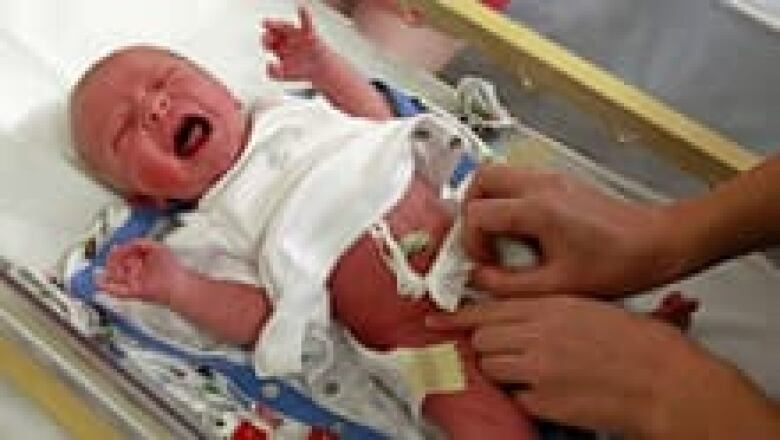Newborn heart defect screening urged
Newborns should be screened for heart defects using a simple, non-invasive test, a new review finds.
Heart defects present at birth are a leading cause of infant deaths. Surgery improves survival of serious cases but newborns may not show signs of the condition early.

For years, hospitals in developed countries have considered using pulse oximetrya measure of the oxygen circulating in the blood stream using a sensor commonly placed on the toe or fingertip to alert staff to low levels that could signal a heart defect.
In Tuesday's online issue of the The Lancet, British researchers analyzed data from studies on 229,421 newborns to see how well pulse oximetry stacks up as a screening method for congenital heart defects in seemingly healthy newborns.
"Heart defects in newborn babies are thankfully rare but their potential impact is devastating," said Dr. Shakila Thangaratinam, a clinical senior lecturer at Queen Mary University of London, who led the research.
"This study is really important because by including such large numbers of babies, we can show that pulseoximetry is effective at picking up defects, without misdiagnosing healthy babies," she added in a release.
Thangaratinam and her co-authors concluded pulse oximetry should be included in universal screening of newborns.
Blue babies
Currently, doctors rely on prenatal ultrasounds and physical exams of the newborn to detect the heart defects but both techniques have a fairly low detection rate and many babies are discharged from hospital before diagnosis, the researchers said.
Pulse oximetry aims to pick up on newborns with low oxygen levels that wouldnt necessarily create visible cyanosisa "blue baby" with a clinically detectable problem.
The reviewers included newborns without symptoms who were screened for critical congenital heart defects that could kill the baby or require invasive procedures like surgery in the first 28 days of life.
Saving Jesse
Greg Beros's son Jesse is grateful that pulse oximetry alerted staff at York Central Hospital to a heart defect that needed immediate surgery at the Hospital for Sick Children in Toronto.
After a normal pregnancy and delivery, Jesse was born in2008,seemingly perfectly healthy.
When he was tested with the device on his toe, the "bells and whistles" went off,his fatherrecalled of the low oxygen reading.
"We kind of got into high panic mode you know when we were down in the NICU," said mother Heather Beros. "He was beginning to turn tinged just around the lip."
Jesse was re-tested in the neonatal intensive care unit, stabilized and then transportedfor open heart surgery to correct how oxygenated blood is pumped in his body.
The 3-year-oldisnow thriving, but doctors said if the test wasn't done,Jessemight have died in his sleep orturned blue and become critically ill.
Doing emergency surgery in that state would have compromised his condition more, which could worsen the outcome, said pediatrician Dr. GeraldFriedman, medical director of the woman and child program atYork Central in Richmond Hill, Ont.
"There is no real down side," said Friedman. "There is nursing time involved but otherwise it's very cost effecive, a very simple test to do and most importantly, there's no pain involved to the baby."
The hospital has identified two babies using pulse oximetry in about eight years, Friedman said.
However, not all hospitals in Canada routinely use itfor newborns.
That's the case at the IWK Health Centre in Halifax.Dr. Andrew Warren, head of pediatric cardiology at IWK, called the study convincing enough that it will likely lead to a change in practice.
Dr. Robert Koppel of Cohen Children's Medical Center in New York City wrote a similar study in the journal in 2003 that inspired Friedman to introduce the screening.
But Koppel said pulse oximetry is not great at finding the most common heart defect.
Screening endorsement
The review suggested that the non-invasive and easy screening works best when done after 24 hours of birth. Somebabies in Canada are discharged before then.
The U.S. is adopting pulse oximetry screening.New Jersey became the first state to implement state-wide screening of newborns in August 2011.
Last year, the American Academy of Pediatrics, American College of Cardiology Foundation and American Heart Association jointly endorsed pulse-oximetry screening in most newborn care settings.
The U.S. groups called for more research on special populations such as at high altitudes and during telemedicine deliveries and for nurseries without echocardiography services to take an ultrasound of the heart on site.
The Canadian Pediatric Society said it does not have a position on adopting pulse oximetry to routinely screen newborns.
The screening isn't foolproof.Pulse oximetry can miss critical heart defects in some babies, the reviewers noted.
Adding pulse oximetry could also have an added benefit in identifying other serious disorders such as group B streptococcal pneumonia, they said.
A journal editorial accompanying the research saidit provides "convincing evidence for introduction of this technique as a screening method in clinical practice."
There was no funding for the research.
With files from CBC's Kelly Crowe












_(720p).jpg)


 OFFICIAL HD MUSIC VIDEO.jpg)
.jpg)



























































































